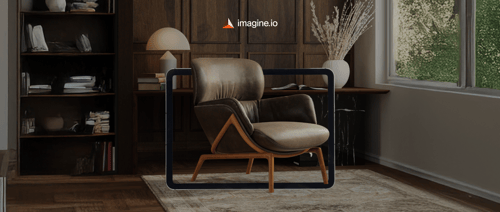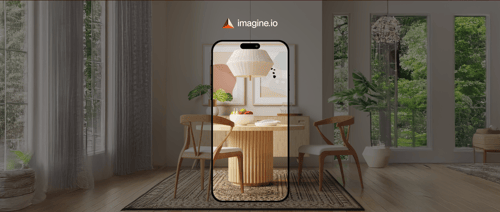In retail, growth isn’t just about more stores or higher sales—it’s about operational efficiency, visual consistency, and speed of execution. If you’re trying to scale without burning out your merchandising team or sinking thousands into photoshoots and manual planograms, then it's time to rethink how you approach your product displays.
And that’s where 3D visualization and merchandising automation come into play. Whether you’re managing ten stores or a thousand SKUs across multiple regions, automating your visual merchandising strategy using 3D tools can simplify operations while enhancing brand consistency and consumer experience.
Let’s walk through how this works, and why so many modern retailers are now making 3D the foundation of their merchandising strategy.
Get the latest updates straight to your inbox.
By clicking sign up you'll receive occasional emails from imagine.io. You always have the choice to unsubscribe within every email you receive.
Why 3D Visualization is Crucial for Scalable Merchandising
You can’t scale what you can’t visualize—and that’s where 3D shines. Traditional merchandising relies heavily on photography, physical samples, and manual mockups. All of which take time, cost money, and aren’t agile.
But 3D product visualization flips the process on its head.
Here’s how:
-
One 3D Model = Infinite Visuals
Once a product is modeled in 3D, it can be used endlessly across campaigns, regions, and platforms. You can rotate it, zoom it, drop it into virtual store setups, or simulate lighting and textures—all without touching the physical item again.
-
Interactive Store Planning
Platforms like imagine.io allow you to build fully interactive planograms with real-time drag-and-drop functionality. Think of it as a virtual sandbox where you can experiment with how your store (or product page) looks before investing a single dollar into production or setup.
-
Cross-Channel Consistency
Your in-store shelves, online product pages, mobile apps, and catalogs can all share the same 3D-rendered visuals—keeping your brand experience cohesive across every touchpoint.
How to Automate Your Merchandising Strategy with 3D
Let’s break down what an automated merchandising pipeline looks like when paired with powerful 3D visualization tools:
-
Start with 3D Product Data
Rather than photographing every product color, size, or variant, you create 3D digital twins—virtual replicas of your physical SKUs. These digital twins aren’t just pretty pictures—they’re data-rich assets that can be reused, resized, and repositioned endlessly.
This eliminates the need for reshoots every time packaging updates or you release a new version. With a 3D asset, a simple tweak in the platform updates your visuals instantly across all marketing and merchandising materials.
-
Create Merchandising Templates
Once your product library is digitized, you move on to setting up visual layouts—what you might know as planograms. With a drag-and-drop interface, you can build modular templates that reflect different store sizes, layouts, or promotional zones.
No need to measure shelves or manually test placements. The digital environment mirrors real-world dimensions, so your layouts are always accurate.
This is especially powerful when you’re managing multiple store formats or regions. You can create a base layout, then duplicate and customize it per need—with far less effort than manual merchandising ever required.
-
Apply Automation Rules
This is where the magic happens. Merchandising isn’t just about how things look—it’s about strategy. You can use logic to automate what gets placed where based on business goals.
For example:
- Place new arrivals at eye-level in every layout
- Push bundled products next to each other
- Prioritize seasonal products in endcaps during promotional windows
- Reconfigure displays automatically based on regional buying trends
Instead of doing this manually store-by-store, automation lets you apply rules globally, and the system builds out the visual layouts accordingly.
-
Localize at Scale
Let’s say your Northeast stores need winter gear front and center while your West Coast stores focus on spring inventory. With traditional methods, that’s a massive lift. But with 3D and automation:
- The system can automatically pull in the relevant SKUs based on location
- Create tailored layouts instantly
- Apply region-specific branding or signage
This type of hyper-local merchandising used to require armies of field merchandisers. Now, it’s possible with just a few clicks.
-
Deploy Across Channels
Once your layout is finalized, you’re not just sending it to one place. With 3D visual assets, the same design can be published across:
- In-store planograms and visual merchandising guides
- eCommerce product pages
- Interactive catalogs and buyer guides
- Virtual showrooms or walkthroughs
- Sales presentations and team training
The Business Benefits: Why It Matters
Scaling retail operations isn’t just about cutting costs—it’s about gaining control, increasing agility, and delivering better shopper experiences. When you combine 3D visualization with merchandising automation, here’s what you unlock:
-
Speed to Market
With 3D and automation, your merchandising updates go from weeks to hours. Launch campaigns faster, respond to trends quicker, and adapt instantly to supply chain shifts or inventory updates.
-
Significant Cost Reduction
No more repeated photoshoots, physical mockups, or shipping samples. A single 3D asset replaces dozens of costly, time-consuming steps in your traditional process.
-
Consistency at Scale
Keep your brand image sharp across every channel and region. Whether it’s a flagship store or an online popup, your visuals stay on-brand because they all come from the same 3D source.
-
Smart Testing & Optimization
Before you spend a dime on printing signage or building displays, you can test layouts virtually. See what works, make tweaks, and deploy only what’s proven to be effective.
-
Improved Collaboration Across Teams
Design, marketing, sales, and operations can all work from the same centralized 3D library—removing silos and aligning faster on visual strategy.
A Realistic Example: How This Works in Practice
Imagine you’re a national retail brand preparing a holiday campaign. Traditionally, you’d need:
- New photos for every product and package
- Manpower to physically arrange products
- Printed guides and manual walkthroughs for each store
Now, with imagine.io:
- You render your holiday collection once in 3D
- Use automation to apply regional rules
- Instantly generate visual plans for 500 stores
- Push those visuals across your website, print catalog, and store displays
The result? Weeks of work done in hours, with better visual consistency and full control at scale.
Final Thoughts
As the retail landscape grows more complex, the path to scalable success lies not in doing more manually—but in doing things more intelligently. By combining 3D visualization with automated merchandising strategies, you gain a faster, more agile, and cost-efficient way to manage product displays, marketing visuals, and store layouts across every touchpoint.
No more bottlenecks, no more guesswork. Just one unified system will power your retail growth, from seasonal rollouts to everyday execution.
Ready to see how it works in action? Book a Free Demo with imagine.io and discover how easy it is to bring your merchandising strategy into the future.


.gif?width=1296&height=1296&name=Untitled%20design%20(8).gif)



.png?width=500&name=How%20to%20Add%20a%203D%20Product%20Configurator%20to%20Your%20WordPress%20Website%20(Complete%20B2B%20Guide).png)
















%20(1).png?width=500&name=Why%20Exploded%20Mattress%20Views%20Matter%20(And%20How%20to%20Generate%20Them)%20(1).png)
.png?width=500&name=Best%20Shopify%20Product%20Configurator_%20How%20to%20Choose%20the%20Right%20One%20(2).png)
.png?width=500&name=Why%20Exploded%20Mattress%20Views%20Matter%20(And%20How%20to%20Generate%20Them).png)



.png?width=500&name=Best%20Shopify%20Product%20Configurator_%20How%20to%20Choose%20the%20Right%20One%20(1).png)







.png?width=500&name=How%203D%20Rendering%20Can%20Make%20or%20Break%20Your%20Industrial%20Design%20Pitch%20(1).png)








%20with%20Digital%20Twins%20and%203D%20Visualization.png?width=500&name=Optimizing%20Your%20Digital%20Asset%20Management%20(DAM)%20with%20Digital%20Twins%20and%203D%20Visualization.png)




.png?width=500&name=Styling%20Home%20Decor%20for%202025_%20From%20Global%20Influences%20to%20Playful%20Personalization%20(1).png)

